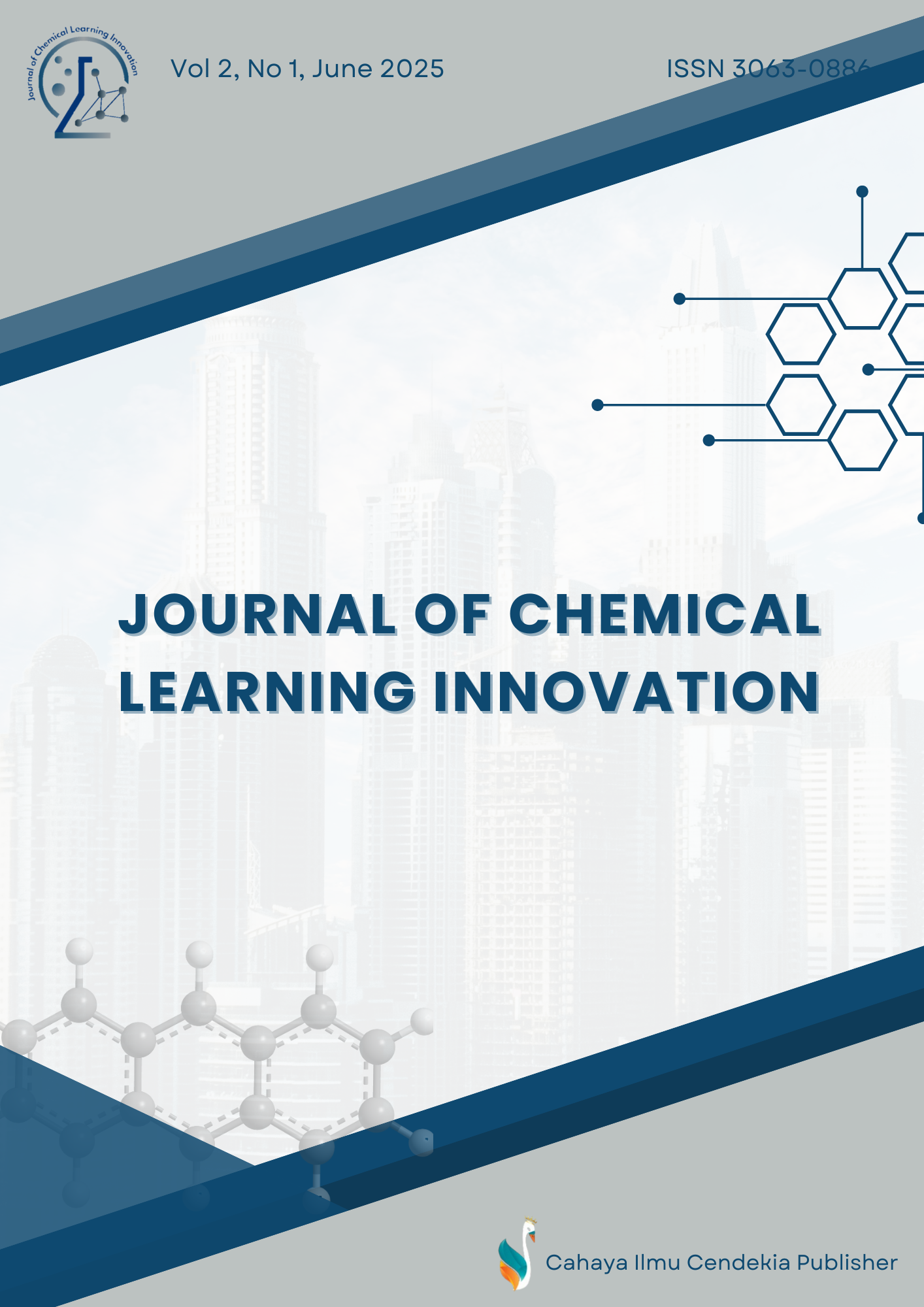Fostering Better Chemistry Learning Outcomes with the Cooperative Integrated Reading and Composition Learning Model
Abstract
Purpose of the study: The purpose of this study was to improve the chemistry learning outcomes by implementing the cooperative learning model of the Cooperative Integrated Reading and Composition type.
Methodology: The subjects in this study were 18 students of class X of LKMD Sukaramai Tapung Hulu Senior High School. While the object of this study is the application of the cooperative learning model of the Cooperative Integrated Reading and Composition type to improve the chemistry learning outcomes of class X students of LKMD Sukaramai Tapung Hulu Senior High School.
Main Findings: Based on the research results, the implementation of cooperative learning strategies of the Cooperative Integrated Reading and Composition type in the learning process in class X of LKMD Sukaramai Tapung Hulu Senior High School increased student learning outcomes. From the analysis of data on the success of the action, it was found that there was an increase in the number of students who had scores above 65 after the action compared to the number of students who had scores above 65 before the action with a percentage of completion of 33.3%, and in the first daily test increased by 55.6%. While in the second daily test, all students (100%) obtained a minimum score or above 65.
Novelty/Originality of this study: The novelty of this study is to determine the effectiveness of implementing the cooperative integrated reading and composition type of cooperative learning model to improve chemistry learning outcomes.
References
A. Dirsa, S. Anggreni BP, C. Diananseri, and I. Setiawan, “Teacher Role as Professional Educator in School Environment,” Int. J. Sci. Educ. Cult. Stud., vol. 1, no. 1, pp. 32–41, Nov. 2022, doi: 10.58291/ijsecs.v1i1.25.
C. Amelia, A. Aprilianto, D. Supriatna, I. Rusydi, and N. E. Zahari, “The Principal’s Role as Education Supervisor in Improving Teacher Professionalism,” Nidhomul Haq J. Manaj. Pendidik. Islam, vol. 7, no. 1, pp. 144–155, Apr. 2022, doi: 10.31538/ndh.v7i1.2075.
S. Setyaningsih and Y. Suchyadi, “Classroom management in improving school learning processes in the cluster 2 teacher working group in north bogor city,” JHSS (JOURNAL Humanit. Soc. Stud., vol. 5, no. 1, pp. 99–104, Mar. 2021, doi: 10.33751/jhss.v5i1.3906.
X. Ma, Y. Xie, and H. Wang, “Construction and Verification Study on the Hierarchical Model of Teacher–Student Interaction Evaluation for Smart Classroom,” Asia-Pacific Educ. Res., vol. 34, no. 3, pp. 1169–1180, Jun. 2025, doi: 10.1007/s40299-024-00931-5.
C. U. Osuji and I. Catherine, “Material Resources Management for Effective Teaching and Learning in Nigerian Tertiary Education : Implications for Quality Tertiary Education Delivery,” Int. J. Innov. Educ. Res., vol. 9, no. 3, pp. 13–28, 2021.
B. L. Moorhouse and K. M. Wong, “Blending asynchronous and synchronous digital technologies and instructional approaches to facilitate remote learning,” J. Comput. Educ., vol. 9, no. 1, pp. 51–70, Mar. 2022, doi: 10.1007/s40692-021-00195-8.
G. M. Chans and M. Portuguez Castro, “Gamification as a Strategy to Increase Motivation and Engagement in Higher Education Chemistry Students,” Computers, vol. 10, no. 10, p. 132, Oct. 2021, doi: 10.3390/computers10100132.
S. McGuire, S. Y. McGuire, and T. Angelo, Teach Students How to Learn. New York: Routledge, 2023. doi: 10.4324/9781003447313.
E. Nsabayezu, O. Habimana, W. Nzabalirwa, and F. N. Niyonzima, “Contribution of Activities-Enhanced Rubrics in the Multimedia-Supported Flipped Classroom Approach on Students’ Conceptual Understanding in Organic Chemistry: A Scoping Review,” Int. J. Technol. Learn., vol. 32, no. 1, pp. 77–112, 2024, doi: 10.18848/2327-0144/CGP/v32i01/77-112.
S. S. Obloqulov, “The Main Tasks of Toxicological Chemistry,” Galaxy Int. Interdiscip. Res. J., vol. 10, no. 11, pp. 168–170, 2022.
A. Baiardi, M. Christandl, and M. Reiher, “Quantum Computing for Molecular Biology,” ChemBioChem, vol. 24, no. 13, pp. 1–24, 2023, doi: 10.1002/cbic.202300120.
S. Zhong et al., “Machine Learning: New Ideas and Tools in Environmental Science and Engineering,” Environ. Sci. Technol., vol. 55, no. 19, pp. 12741–12754, Oct. 2021, doi: 10.1021/acs.est.1c01339.
D. Mandler, R. Mamlok-Naaman, R. Blonder, M. Yayon, and A. Hofstein, “High-school chemistry teaching through environmentally oriented curricula,” Chem. Educ. Res. Pr., vol. 13, no. 2, pp. 80–92, 2012, doi: 10.1039/C1RP90071D.
E. S. Beach, Z. Cui, and P. T. Anastas, “Green Chemistry: A design framework for sustainability,” Energy Environ. Sci., vol. 2, no. 10, p. 1038, 2009, doi: 10.1039/b904997p.
A. T. Najafabadi, “CO 2 chemical conversion to useful products: An engineering insight to the latest advances toward sustainability,” Int. J. Energy Res., vol. 37, no. 6, pp. 485–499, May 2013, doi: 10.1002/er.3021.
J. Martínez, J. F. Cortés, and R. Miranda, “Green Chemistry Metrics, A Review,” Processes, vol. 10, no. 7, p. 1274, Jun. 2022, doi: 10.3390/pr10071274.
C. C. Seah et al., “Co-pyrolysis of biomass and plastic: Circularity of wastes and comprehensive review of synergistic mechanism,” Results Eng., vol. 17, p. 100989, Mar. 2023, doi: 10.1016/j.rineng.2023.100989.
R. Silva, C. Farias, and I. Mesquita, “Cooperative Learning Contribution to Student Social Learning and Active Role in the Class,” Sustainability, vol. 13, no. 15, p. 8644, Aug. 2021, doi: 10.3390/su13158644.
J. Colomer, D. Cañabate, B. Stanikūnienė, and R. Bubnys, “Formulating Modes of Cooperative Leaning for Education for Sustainable Development,” Sustainability, vol. 13, no. 6, p. 3465, Mar. 2021, doi: 10.3390/su13063465.
S. Narulita and S. Armadi, “Improving writing ability through cooperative integrated reading and composition (circ),” LOA J. Ketatabahasaan dan Kesusastraan, vol. 18, no. 1, Jun. 2023, doi: 10.26499/loa.v18i1.6022.
N. Nurainun and S. Nasution, “The Influence of the CIRC Learning Model (Cooperative, Integrated, Reading, and Composition) on the Reading Skills Students at Islamic Elementary School,” Scaffolding J. Pendidik. Islam dan Multikulturalisme, vol. 6, no. 2, pp. 38–57, Jul. 2024, doi: 10.37680/scaffolding.v6i2.5172.
Z. P. Putri, N. Hermita, and E. A. Mulyani, “Enhancing Reading Comprehension in Fourth Graders: Evaluating the Impact of the Cooperative Integrated Reading Composition (CIRC) Model,” AL-ISHLAH J. Pendidik., vol. 17, no. 2, Jun. 2025, doi: 10.35445/alishlah.v17i2.5406.
J. Patty, “Enhancing Reading Comprehension through the Cooperative Integrated Reading and Composition (CIRC) Strategy,” Enhancing Read. Compr. through…, vol. 3, no. 4, pp. 362–377, 2023.
M. Haturrahma, K. Salija, and G. Sakkir, “The Implementation of Cooperative Integrated Reading and Composition (CIRC) Strategy in Teaching Students Writing Skill at Junior High School,” Celeb. J. Lang. Stud., vol. 3, no. 2, pp. 219–228, Nov. 2023, doi: 10.51629/cjls.v3i2.147.
E. A. Dare, K. Keratithamkul, B. M. Hiwatig, and F. Li, “Beyond Content: The Role of STEM Disciplines, Real-World Problems, 21st Century Skills, and STEM Careers within Science Teachers’ Conceptions of Integrated STEM Education,” Educ. Sci., vol. 11, no. 11, p. 737, Nov. 2021, doi: 10.3390/educsci11110737.
A. M. Hasanein and A. E. E. Sobaih, “Drivers and Consequences of ChatGPT Use in Higher Education: Key Stakeholder Perspectives,” Eur. J. Investig. Heal. Psychol. Educ., vol. 13, no. 11, pp. 2599–2614, Nov. 2023, doi: 10.3390/ejihpe13110181.
D. Arwen and S. Haq, “THE EFFECT OF COOPERATIVE INTEGRATED READING AND COMPOSITION LEARNING METHOD TOWARDS FABLE WRITING SKILLS,” English Rev. J. English Educ., vol. 10, no. 1, pp. 323–336, Mar. 2022, doi: 10.25134/erjee.v10i1.5721.
M. S. Shobirin and M. Wafiroh, “Application of The Circ Learning Model to Improve Student’s Reading and Writing Skills in The Yellow Kitab Subject,” Sch. Soc. Lit. Study Educ., vol. 1, no. 2, pp. 84–87, Sep. 2021, doi: 10.32764/schoolar.v1i2.1464.
M. Nasution, “The Effect of CIRC (Cooperative, Integrated, Reading and Composition) Method on Students Achievement in Reading Recount Text,” Edunesia J. Ilm. Pendidik., vol. 3, no. 2, pp. 136–148, Feb. 2022, doi: 10.51276/edu.v3i2.235.
R. F. Dewinna, “Analysis of the Use of the Cooperative Integrated Reading and Composition (CIRC) Method in Improving Elementary School Students’ English Reading and Writing Skills,” Int. J. Curric. Dev. Teach. Learn. Innov., vol. 3, no. 2, pp. 69–79, Mar. 2025, doi: 10.35335/curriculum.v3i2.215.
F. Aryani and D. Andrianto, “Enhancing The Fifth Aspect’s of Writing By Cooperative Integrated Reading And Composition (CIRC),” Symfonia J. Pendidik. Agama Islam, vol. 4, no. 1, pp. 1–18, Jun. 2024, doi: 10.53649/symfonia.v4i1.83.
Yusnidar, I. Mauliana, N. Ulfa, and A. Fitria, “Improving Student Learning Outcomes with the Problem Based Learning Model: Classroom Action Research at the State Islamic Primary School,” Indones. J. Educ. Soc. Humanit., vol. 1, no. 2, pp. 1–8, Jun. 2024, doi: 10.62945/ijesh.v1i2.62.
W. Lestari and A. Widayati, “Implementation of Teams Games Tournament to Improve Student’s Learning Activity and Learning Outcome: Classroom Action Research,” AL-ISHLAH J. Pendidik., vol. 14, no. 4, pp. 5587–5598, Sep. 2022, doi: 10.35445/alishlah.v14i4.1329.
R. M. Putra, S. Solekhah, D. D. Agustina, and B. Sobirov, “Action Learning Strategy to Enhance Students Speaking Skill: A Classroom Action Research,” Anglophile J., vol. 2, no. 1, p. 37, Jan. 2022, doi: 10.51278/anglophile.v2i1.269.
M. Nazari, “Plan, Act, Observe, Reflect, Identity: Exploring Teacher Identity Construction across the Stages of Action Research,” RELC J., vol. 53, no. 3, pp. 672–685, Dec. 2022, doi: 10.1177/0033688220972456.
S. Wahyu, F. Rizal, and N. Syah, “Teacher Performance Analysis in the Learning Process,” J. Educ. Res. Eval., vol. 5, no. 1, p. 67, Jan. 2021, doi: 10.23887/jere.v5i1.30758.
A. Bazan-Ramirez, N. M. Velarde-Corrales, M. E. Rodriguez-Perez, J. Guerrero-Barrios, and R. B. Anaya-Gonzalez, “Observational Record and Self-Report of Teacher-Student Performance in High School Lessons,” Int. J. Educ. Methodol., vol. 8, no. 3, pp. 479–491, 2022, doi: 10.12973/ijem.8.3.479.
I. Apriyanti, Leginem, and S. Rahayu, “Efforts to Improve Student Learning Outcomes through the Problem Based Learning Model in Islamic Education Learning at SD Negeri 104325 Kampung Manggis,” J. Indones. Prim. Sch., vol. 1, no. 2, pp. 61–68, Jun. 2024, doi: 10.62945/jips.v1i2.346.
N. Lestari, M. Winarsih, and D. Kusumawardani, “The Use of Meaningful Learning in Distance Learning,” JTP - J. Teknol. Pendidik., vol. 25, no. 1, pp. 42–53, Apr. 2023, doi: 10.21009/jtp.v25i1.33701.
F. Daryanes and I. Sayuti, “Research-based learning in biology courses to train students critical thinking skills: Student’s perception,” Biosfer, vol. 16, no. 1, pp. 124–137, Apr. 2023, doi: 10.21009/biosferjpb.23160.
S. Rahmah and A. H. Lubis, “Problem Posing as a Learning Model to Improve Primary School Students’ Mathematics Learning Outcomes in Gayo Lues,” J. Indones. Prim. Sch., vol. 1, no. 4, pp. 93–104, Dec. 2024, doi: 10.62945/jips.v1i4.409.
P. Goldberg, J. Schwerter, T. Seidel, K. Müller, and K. Stürmer, “How does learners’ behavior attract preservice teachers’ attention during teaching?,” Teach. Teach. Educ., vol. 97, p. 103213, Jan. 2021, doi: 10.1016/j.tate.2020.103213.
N. R. Moşteanu, “Teaching and Learning Techniques for the Online Environment. How to Maintain Students’ Attention and Achieve Learning Outcomes in a Virtual Environment Using New Technology,” Int. J. Innov. Res. Sci. Stud., vol. 4, no. 4, pp. 278–290, 2021, doi: 10.53894/ijirss.v4i4.298.
G. Sakkir and M. Haturrahma, “The Challenges in Teaching Writing through Cooperative Integrated Reading and Composition (CIRC) Strategy,” ARRUS J. Soc. Sci. Humanit., vol. 3, no. 3, pp. 391–396, Jun. 2023, doi: 10.35877/soshum1971.
B. Chaves-Yuste and C. de-la Peña, “Cooperative Integrated Reading and Composition Model to Improve EFL Reading Comprehension and Foster Inclusive Education,” Int. J. Literacies, vol. 30, no. 1, pp. 1–18, 2022, doi: 10.18848/2327-0136/CGP/v30i01/1-18.
Copyright (c) 2025 Nur Mustofa, Indah Sri Wahyuni

This work is licensed under a Creative Commons Attribution 4.0 International License.
Authors who publish with this journal agree to the following terms:
- Authors retain copyright and acknowledge that the Journal of Chemical Learning Innovation is the first publisher licensed under a Creative Commons Attribution 4.0 International License.
- Authors are able to enter into separate, additional contractual arrangements for the non-exclusive distribution of the journal's published version of the work (e.g., post it to an institutional repository or publish it in a book), with an acknowledgment of its initial publication in this journal.
- Authors are permitted and encouraged to post their work online (e.g., in institutional repositories or on their website) prior to and during the submission process, as it can lead to productive exchanges and earlier and greater citation of published work.





.png)
.png)










